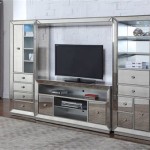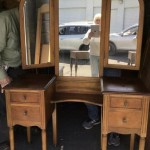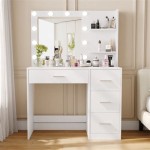Antique Oak Framed Beveled Mirrors: History, Craftsmanship, and Value
Antique oak framed beveled mirrors represent a captivating intersection of functionality, artistry, and historical significance. These mirrors, often dating back to the late 19th and early 20th centuries, possess a unique charm that transcends mere reflection. They are coveted for their robust construction, the warmth and character of the oak wood, the intricate detailing of the frames, and the elegant refraction of light facilitated by the beveled edge. Understanding the history, craftsmanship, and factors influencing their value is crucial for collectors, interior designers, and anyone seeking to appreciate these enduring pieces.
The popularity of oak as a material for furniture and decorative objects, including mirror frames, surged during the Victorian era and continued into the early 20th century. Oak’s strength, durability, and readily available supply made it a practical choice. Furthermore, its distinctive grain patterns allowed for a wide range of finishes, from light and honeyed tones to darker, more dramatic shades. The use of oak in framing mirrors mirrored a broader trend in home decor, reflecting a preference for sturdy, substantial pieces that exuded a sense of permanence and reliability.
The beveled edge, a key characteristic of these mirrors, adds a touch of refinement and visual interest. The process of beveling involves grinding down the edge of the glass at an angle, creating a sloped surface that refracts light, producing a shimmering effect. This technique, while requiring specialized tools and skilled craftsmanship, was highly valued for its aesthetic appeal. Beveled edges enhanced the perceived depth and elegance of the mirror, making it a focal point within a room.
The History and Evolution of Oak Framed Mirrors
The Victorian era, spanning from 1837 to 1901, saw a burgeoning interest in ornate and decorative elements in home interiors. Mirrors, previously considered luxury items, became increasingly accessible and popular. Oak, with its association with strength and stability, became a favored material for framing these mirrors. During this period, oak framed mirrors often featured elaborate carvings, including floral motifs, geometric patterns, and representations of naturalistic scenes. The frames themselves became works of art, complementing the reflective surface and adding to the overall aesthetic richness of the piece.
The Arts and Crafts movement, which emerged in the late 19th century as a reaction against industrial mass production, also embraced oak as a preferred material. However, in contrast to the ornate Victorian style, the Arts and Crafts aesthetic emphasized simplicity, honesty of construction, and the inherent beauty of natural materials. Oak framed mirrors produced during this period tended to feature cleaner lines, less elaborate carvings, and a focus on showcasing the natural grain of the wood. Joinery techniques, such as mortise and tenon joints, were often deliberately exposed to highlight the craftsmanship involved in their creation.
The early 20th century witnessed the rise of the Art Nouveau and Art Deco styles, which also left their mark on mirror design. While oak remained a viable material, these styles often incorporated other materials, such as exotic woods, metals, and decorative glass elements. Art Nouveau oak framed mirrors frequently featured flowing, organic lines and stylized depictions of flowers and foliage. Art Deco mirrors, on the other hand, showcased geometric patterns, streamlined shapes, and a sense of modern sophistication. The use of oak in these styles often involved incorporating it as a background element or as a contrasting material to highlight other decorative features.
Craftsmanship and Construction Techniques
The quality and value of an antique oak framed beveled mirror are significantly influenced by the craftsmanship involved in its construction. Several key aspects of craftsmanship contribute to the overall appeal and longevity of these pieces. The first is wood selection. Experienced craftsmen carefully selected high-quality oak planks, paying attention to the grain pattern, color, and absence of defects. Quarter-sawn oak, which is cut at a specific angle to the tree's growth rings, was particularly prized for its stability and distinctive ray flecks. Careful selection ensured that the frame would be resistant to warping and cracking over time.
The creation of the frame itself required precise joinery techniques. Mortise and tenon joints, dovetail joints, and mitered corners were commonly employed to create strong and durable connections between the individual pieces of wood. Hand-carving skills were essential for creating decorative details, such as floral motifs, geometric patterns, and intricate moldings. The level of detail and the precision of the carving directly impacted the aesthetic value of the mirror.
The beveling of the mirror glass was a specialized skill that required considerable expertise. The process involved grinding down the edge of the glass at a precise angle, creating a smooth and even beveled surface. This was typically done using a series of abrasive wheels and polishing compounds. The quality of the bevel was judged by its clarity, uniformity, and the absence of any chips or imperfections.
The finishing process played a crucial role in enhancing the beauty and protecting the wood. Various finishes, such as varnish, lacquer, and wax, were applied to the frame to seal the wood, highlight the grain pattern, and provide a protective layer against moisture and scratches. The choice of finish could also influence the overall aesthetic of the mirror, ranging from a light and natural look to a darker and more formal appearance.
Factors Influencing Value and Identifying Authentic Pieces
Determining the value of an antique oak framed beveled mirror involves considering a range of factors, including its age, condition, rarity, craftsmanship, and provenance. The older the mirror, typically the higher its potential value, assuming that it is in good condition. Mirrors dating back to the Victorian era or earlier are generally more sought after than those from the early 20th century. Condition is paramount. Mirrors in pristine condition, with minimal wear and tear, command higher prices. Damage, such as cracks in the glass, chips in the bevel, or significant damage to the frame, can significantly reduce its value. Restoration can improve the appearance of a mirror, but over-restoration can sometimes diminish its authenticity and desirability.
Rarity also plays a significant role. Mirrors with unique designs, unusual features, or those produced by well-known makers are considered more valuable. Provenance, or the history of ownership, can also enhance the value of a mirror. If the mirror can be traced back to a prominent historical figure or a significant event, it may be worth more to collectors. The quality of the craftsmanship is a key determinant of value. Mirrors with intricate carvings, precise joinery, and a high-quality bevel are considered more desirable than those with simpler designs and inferior construction. The type of oak used can also influence value. Quarter-sawn oak, with its distinctive ray flecks, is often more highly prized than plain-sawn oak.
Identifying an authentic antique oak framed beveled mirror requires careful observation and attention to detail. Look for signs of age, such as wear and tear, discoloration, and subtle imperfections in the glass and wood. Examine the joinery techniques closely to determine if they are consistent with the period in which the mirror was made. Check for any signs of modern replacement parts or repairs. Original hardware, such as the backing, hinges, and hanging mechanisms, can be a valuable indication of authenticity. Researching the maker's marks or labels can also help to verify the age and origin of the mirror. Consult with experienced antique dealers or appraisers to obtain an accurate assessment of its value and authenticity.
The presence of original labels or maker's marks is a significant indicator of authenticity and can greatly increase the value of an antique mirror. These marks often provide information about the manufacturer, the date of production, and the materials used. Researching these marks can help to verify the age and origin of the mirror and provide valuable insights into its history.
Antique Oak Framed Beveled Mirror

Antique Oak Framed Beveled Mirror Chairish

Antique Oak Framed Mirror Beveled 46 X 24 Long Valley Traders

Antique Oak Framed Beveled Mirror Birchard Hayes Company Inc

Antique French Carved Oak Frame Beveled Mirror Wall Mantel Louis Xiv Renaissance For At 1stdibs Orna Aged

Art Deco Bevelled Oak Mirror 1920s For At Pamono

Antique Oak Framed Mirror Huisraad Modern

Antique French Mirror Oak Framed Hanging Wall Beveled Ruby Lane

Antique Oak Beveled Mirror S For

Large Antique Oak Beveled Mirror At 1stdibs Glass Vintage Mirrors








